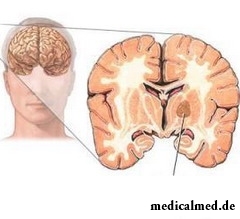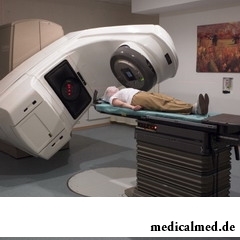





Glioblastoma
Glioblastoma –  the most often meeting and one of the most artful tumors of a brain.
the most often meeting and one of the most artful tumors of a brain.
Glioblastoma of a brain: features, etiology, classification, diagnosis.
Insidiousness of a glioblastoma of a brain is that its germination in brain fabric happens promptly. Most often it is localized in a forehead and temples; its dislocation is always located in a brain.
The etiology (reason) of development of a glioblastoma of a brain is authentically not established today. The hypothesis of a negative impact of means of mobile communication in its emergence was not confirmed. At the same time the following risk factors of development of a glioblastoma are noted:
- men are ill more often than women;
- most often the disease is characteristic of aged people from 40 to 60 years;
- regular influence of the ionized radiation or some chemicals (for example, polyvinylchloride).
According to classification of the World Health Organization (WHO) the 4th degree of a zlokachestvennost is appropriated to a glioblastoma.
Distinguish three versions glioblasty:
- giant-cell,
- multiformny,
- to gliosarky.
Apply modern informative and high-precision methods of inspection to confirmation of the diagnosis of a glioblastom of a brain – the magnetic and resonant tomography (MRT) with administration of contrast medium, and also SPEKT and PET of scanning.
At the same time it is noted that in certain cases character of the received image can not correspond to disease severity. The final analysis at diagnosis of a glioblastom is the stereotaxic biopsy of cells of a new growth and their pathoanatomical research.
Glioblastoma symptoms
It is obvious that development of a glioblastoma of a brain is followed by an intensive headache. Patients complain of deterioration in sight, numbness of extremities, drowsiness. Increase in intracranial pressure, dizziness is noted. At a number of patients epileptic seizures are recorded. Relatives of the person from glioblastomy notice a dysmnesia and change of the personality. Tragic element of a situation consists in what before emergence of the first symptoms of a glioblastom grows to the hypertrophied sizes.
Modern approach to treatment of a glioblastoma
Treatment of a glioblastoma consists of three stages:
- operative measure for the purpose of full removal of a new growth;
- kombinatsiyaluchevy therapy and drug treatment;
- chemotherapy for maintenance of effect.
Only full  removal of a glioblastoma allows to provide duration and quality of life of the patient. Difficulty of this stage is caused by lack of clear visible boundary of a glioblastoma of a brain against the background of the inflamed and edematous surrounding fabrics.
removal of a glioblastoma allows to provide duration and quality of life of the patient. Difficulty of this stage is caused by lack of clear visible boundary of a glioblastoma of a brain against the background of the inflamed and edematous surrounding fabrics.
In the recent past radical removal was impossible as the risk was extremely high to touch functional zones of a brain during neurosurgical intervention, having caused paralysis, etc. Today apply a contrast agent to full excision of a glioblastoma - 5-aminolevulinic acid. Operation is performed with use of the special microscope having a source of a blue luminescence. Cells of a tumor are visualized - begin to shine that gives the chance to the surgeon to remove it without the rest.
The subsequent combined treatment of a glioblastoma lasts about 1,5 months. Within five days a week throughout all this term the patient receives the dosed radiation, and Temodal receives medicine daily without breaks.
A month later after the termination of radiotheraphy Temodal's reception is resumed. The supporting course consists of 6 stages, each of which lasts 5 days. The interval between stages makes 23 days.
Approximately in 10% of cases the recurrent current of a glioblastoma of a brain is observed. Since 2005, for treatment of such patients successfully use drug Avastin.
To tell even the shortest and simple words, we involve 72 muscles.

80% of women at least once to lives complained of discomfortable feelings to breasts, consolidations and nagrubaniye. These are mastopathy symptoms. Mas...
Section: Articles about health
For the time being the perspective of heart diseases seems to most of people remote and foggy. But sooner or later practically each adult faces extremely unpleasant feelings: sudden stethalgia. To be consoled at this time in a thought of t...
Section: Articles about health
Iodine - one of thirty most important microelements in our organism. The main role of iodine consists in synthesis of thyroid hormones of a thyroid gland - the substances which are responsible for the majority of exchange processes of an organism. It is known that thyroid hormones consist of iodine more than for 65%. The lack of iodine leads to decrease in production of hormones and, as a result, development of a hypothyroidism. The long condition of deficit can become a source of problems of the cardiovascular, bone, digestive SI...
Section: Articles about health
(Xerostomia) many people consider feeling of a xerostomia small and easily removable inconvenience. This delusion...
Section: Articles about health
At this plant there are a lot of names: tuberiferous sunflower, Jerusalem artichoke, solar root, earth pear. Contrary to popular belief, it is not an exotic plant at all. The wild girasol grows in a midland of Russia practically everywhere: at the edges of roads...
Section: Articles about health
Wood louse – the ordinary-looking unpretentious plant extended in all territory of our country. It quickly expands, and sometimes fills sites, bringing a lot of chagrin to gardeners. Perhaps, they would be upset less if knew that the wood louse is valuable medicinal raw materials. A, C and E vitamins, organic acids, tannins, wax, saponins, lipids, mineral salts and essential oils are its part....
Section: Articles about health
Statistically, pathologies of a thyroid gland in the world more than 500 million people have. Failures in work of this body conduct to is heavy...
Section: Articles about health
The unpleasant feelings connected with spring breakdown are familiar almost to each of us. Often happens that in March-April on the person weakness leans: he suffers from drowsiness, complains of bad mood, loss of interest in life and failures in affairs....
Section: Articles about health
Coffee - the tonic loved by many for the invigorating aroma and deep taste. Having the stimulating effect, coffee increases working capacity, promotes concentration of attention, fights against drowsiness and improves mood. Statistically, about 30% of inhabitants of the planet regularly use coffee, from them more than 8% are "coffee-achievers" - the persons using more than 3 cups of drink a day....
Section: Articles about health
Aging — natural and inevitable process. Over time our skin loses elasticity, on it saggings, a face form теря are formed...
Section: Articles about health
Within several decades of our compatriots convinced that the use of butter nasty affects a condition of coronary vessels. As a result the reputation of a product was impaired thoroughly a little, and many almost ceased to include...
Section: Articles about health
Scientists always aimed to offer fundamental explanations for medical problems. Their theories formed the basis of modern methods of treatment of the hardest pathologies and helped to save a set of lives. However stories are known also such theoretical constructions, following to which brought to mankind of a trouble and torture, ruined destinies and health of many people....
Section: Articles about health
Run - one of the most available and effective ways to revitalize the organism. Knowing about its extraordinary advantage, each of us though...
Section: Articles about health
Cystitis, or inflammation of a mucous membrane of a bladder, this very widespread disease which, owing to some features of a structure of bodies of urinogenital system, women have approximately four times more often than men. In the main risk group...
Section: Articles about health
History of cultivation of a buckwheat contains more than five thousand years. Grain which is received from this plant is used for preparation of porridges, soups, baked puddings and puddings, do flour which is one of the main ingredients of the noodles popular in many countries of it. Buckwheat dishes are useful and tasty, they are perfectly combined with meat, milk, eggs, mushrooms, fruit and vegetables....
Section: Articles about health
History of use of an anesthesia during operations contains more than 160 years. Annually in the world hundreds of thousands surgical вм are carried out...
Section: Articles about health
Visit of doctors – business not the most pleasant, and many people do not hurry to undergo necessary planned inspections. Such behavior is extremely thoughtless and improvident. Our health is necessary not only to us: wellbeing of darlings, children, grandsons and престар...
Section: Articles about health
The Genetically Modified Organisms (GMO) are plants or animals (as a rule, agricultural) to whose genotype purposeful changes were made. Opposition of supporters and opponents of inclusion of such organisms in foodstuff always was very acute. Not only scientists and dietitians, but also a large number of the people who are not specialists in this question are involved in active disputes today....
Section: Articles about health
The words "disease" and "patient" not without reason come from one root – "pain". As a rule, symptoms of illnesses thoroughly spoil the patient...
Section: Articles about health
Scientists have no unambiguous opinion on a proximate cause of emergence of a carcinoma cutaneum today. Only the factors promoting development of this illness are precisely established. Treat them: long impact on skin of ultraviolet rays, radioactive...
Section: Articles about health
Extracorporal fertilization – one of the most modern methods of controlling with infertility. So far he already helped a significant amount of married couples to become happy parents. Usually to the EKO procedure difficult and very expensive, resort in those situations when all other ways to help couple to bring the child are inefficient. "Conception in a test tube" yields quite good results in cases of infertility of one of partners, existence at the woman of impassability of uterine tubes...
Section: Articles about health
The summer of this year in Russia was very ambiguous. Regions suffered from a merciless heat, from pouring rains, from times...
Section: Articles about health
Reactive pancreatitis - the disease which is characterized by inflammatory process in a pancreas which arises most often because of excess activity of digestive enzymes. It − the emergency state which treatment has to take place in хирургич...
Section: Articles about health
The next flu epidemic leads to the next panic, from year to year we give in on these manipulations: professionally alarming voice of the announcer in news, reports with calculation of the died patients, an interview with people in white dressing gowns and advertizing of anti-influenza means of different degree of inefficiency. All this reminds the Hollywood movies of epidemics threatening to destroy our planet. However, there is also one more similarity to cinema: everything comes to an end well. So, how to deal with the events, not in...
Section: Articles about health
Bulimia and anorexia, are heavy deviations of a feeding behavior, become a cause of death of patients much more often than all others...
Section: Articles about health
Life of the modern child is extremely active and difficult. Information strain which is experienced by the school student and did not dream pupils of last times. Careful parents, wishing well to the children, will organize a set of additional classes in circles, sports...
Section: Articles about health
The technique of acupuncture (acupuncture) is used in the medical purposes more than three and a half millennia. It is eurysynusic and recognized as official medicine in the majority of the developed countries of the world. Influence by fine needles on so-called points of acupuncture contributes to normalization of a metabolism and hormonal background, activates protective forces of an organism, has anesthetic and antiinflammatory effect, stabilizes a condition of mentality....
Section: Articles about health
